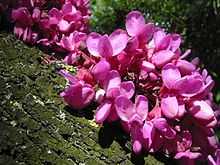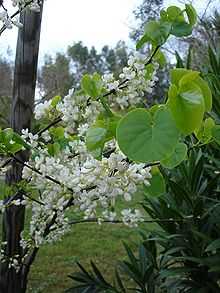Cercis siliquastrum
| Judas Tree | |
|---|---|
 | |
| Scientific classification | |
| Kingdom: | Plantae |
| (unranked): | Angiosperms |
| (unranked): | Eudicots |
| (unranked): | Rosids |
| Order: | Fabales |
| Family: | Fabaceae |
| Genus: | Cercis |
| Species: | C. siliquastrum |
| Binomial name | |
| Cercis siliquastrum L. | |
| Synonyms | |
| |
Cercis siliquastrum, commonly known as the Judas tree, is a small deciduous tree from Southern Europe and Western Asia which is noted for its prolific display of deep pink flowers in spring.
Description


This species forms a small tree up to 12 metres in height and 10 metres in width.[1]
The deep pink flowers are produced on year-old or older growth, including the trunk in late spring (cauliflory). The leaves appear shortly after the first flowers emerge. These are heart-shaped with a blunt apex, which occasionally has a shallow notch at the tip. The tree produces long flat pods that hang vertically. The flowers are edible and purportedly have a sweet-acid taste.[1]
Taxonomy

The species was first described by Linnaeus in 1753 and he gave it the specific epithet of siliquastrum which is derived from the Latin word siliqua, meaning "pod".[2] The generic name comes from the Greek kerkis, a "shuttle", which refers to the resemblance shown to this weaver's tool by the flat, woody seedpods.[3]
There are several varieties and subspecies and these include:
- var. hebecarpa Bornm.
- nothosubsp. yaltikirii (Ponert) Govaerts
- var. siliquastrum
- var. alba Weston
There is a long-standing myth that Judas Iscariot hanged himself from a tree of this species. This belief is related to the common name "Judas tree", which is possibly a corrupted derivation from the French common name, Arbre de Judée, meaning tree of Judea, referring to the hilly regions of that country where the tree used to be common.[4] Another possible source for the vernacular name is the fact that the flowers and seedpods can dangle direct from the trunk in a way reminiscent of Judas' suicide.[3]
Distribution and ecological aspects



The flowers are pollinated by bees, attracted by nectar. Pollen from the protuding stamens is deposited on the bee's body and carried to another flower's stigma.[5]
Cultivation
The species prefers deep, well-drained soils and a position in full sun or partial shade.[1] This plant has gained the Royal Horticultural Society's Award of Garden Merit.[6]
Cultivars include:
- 'Afghan Deep Purple'[7]
- 'Alba' - white flowers[7]
- 'Bodnant'[7]
- 'Carnea'[7]
- 'Fructa Rubra'[7]
- 'Penduliflora'[7]
- 'Rubra' - dark pink-purple flowers
- 'Sterilis'[7]
- 'Variegata'[7]
- 'White Swan'[7]
The tree is susceptible to leafhoppers, scale insects and psyllids (specifically Cacopsylla pulchella) as well as diseases including canker, coral spot and verticillium wilt.
Propagation is by seed, cuttings or budding.
The species produces hard wood with an attractive grain. It is used in veneers and polishes well.[1]
Cultural references
- The Judas Tree (Jonathan Creek)
- Chapter 7 of V. by Thomas Pynchon
- Flowering Judas by Katherine Anne Porter
- Fictionally used to poison The Doctor in the 2011 episode of Doctor Who, "Let's Kill Hitler"
- In the fourth episode of the fifth season of the HBO television series True Blood, the leader of the vampires, Roman, uses a stake made of Cercis siliquastrum to stake another vampire.
- The surname of Hinagiku Katsura (Hayate the Combat Butler), who has pink hair, means Judas Tree in Japanese.
References
- ↑ 1.0 1.1 1.2 1.3 "Cercis siliquastrum- L.". Plants For A Future. Retrieved 13 September2011.
- ↑ Rowell, Raymond J. (1980). Ornamental Flowering Trees in Australia. Australia: AH & AW Reed Pty Ltd Reed. ISBN 0-589-50178-X.
- ↑ 3.0 3.1 Rumsey, Fred. "Cercis siliquastrum (Judas tree)". Natural History Museum. Retrieved 2013-01-04.
- ↑ Mabberley, D.J. (2008). Mabberleys's plant-book (3 ed.). Cambridge University Press. p. 170. ISBN 978-0-521-82071-4.
- ↑ Hickey, Michael; Clive King. "100 families of flowering plants". Cambridge University Press. Retrieved 13 September 2011.
- ↑ http://apps.rhs.org.uk/plantselector/plant?plantid=373
- ↑ 7.0 7.1 7.2 7.3 7.4 7.5 7.6 7.7 7.8 Hatch, Laurence (2007). Cultivars of Woody Plants Volume I (A-G). Raleigh, North Carolina: TCR Press. Retrieved 13 September 2011.
- International Legume Database & Information Service (ILDIS): Cercis siliquastrum
- The Royal Horticultural Society : Circus siliquastrum
- Wildflowers of Israel : Judas tree
| Wikimedia Commons has media related to Cercis siliquastrum. |